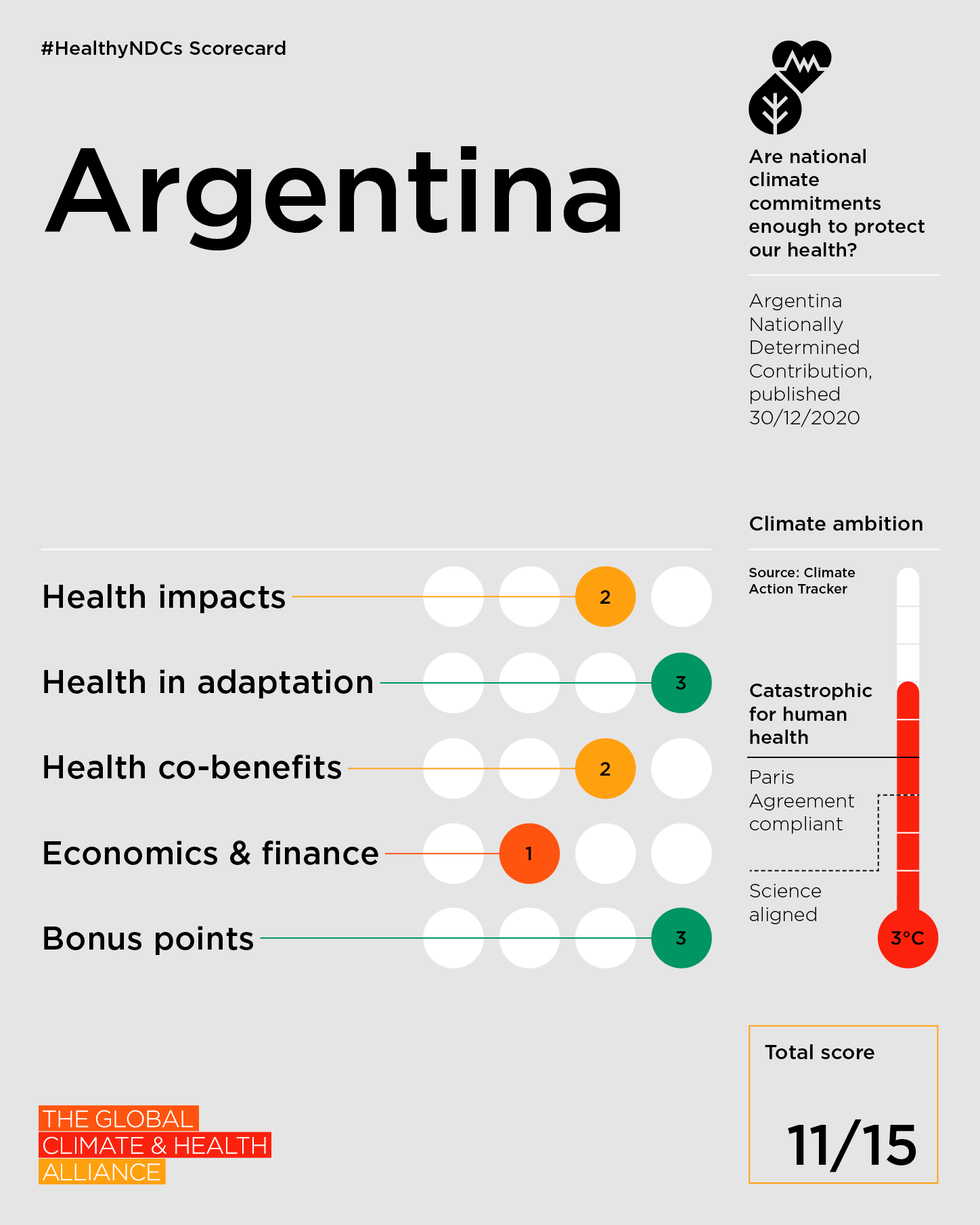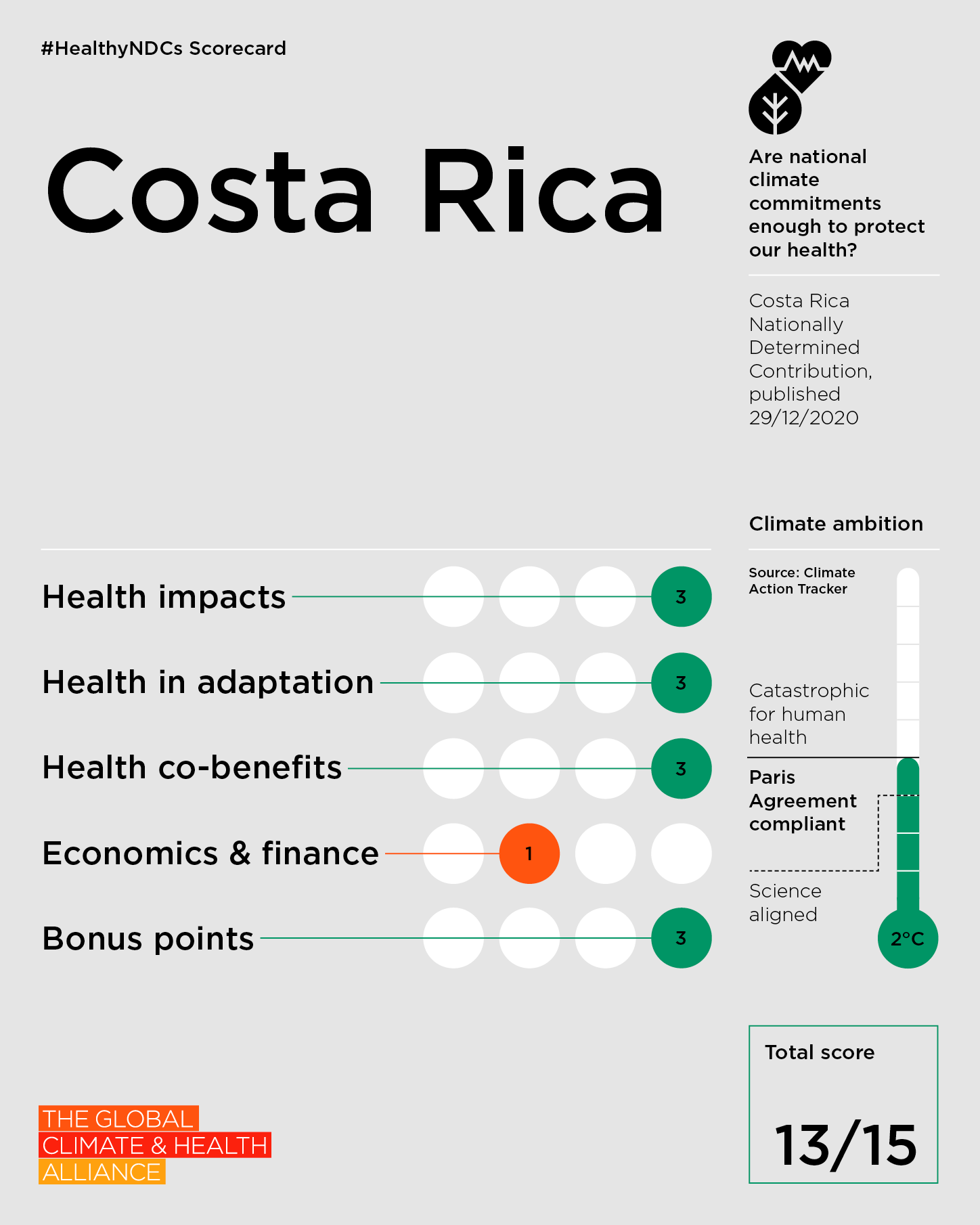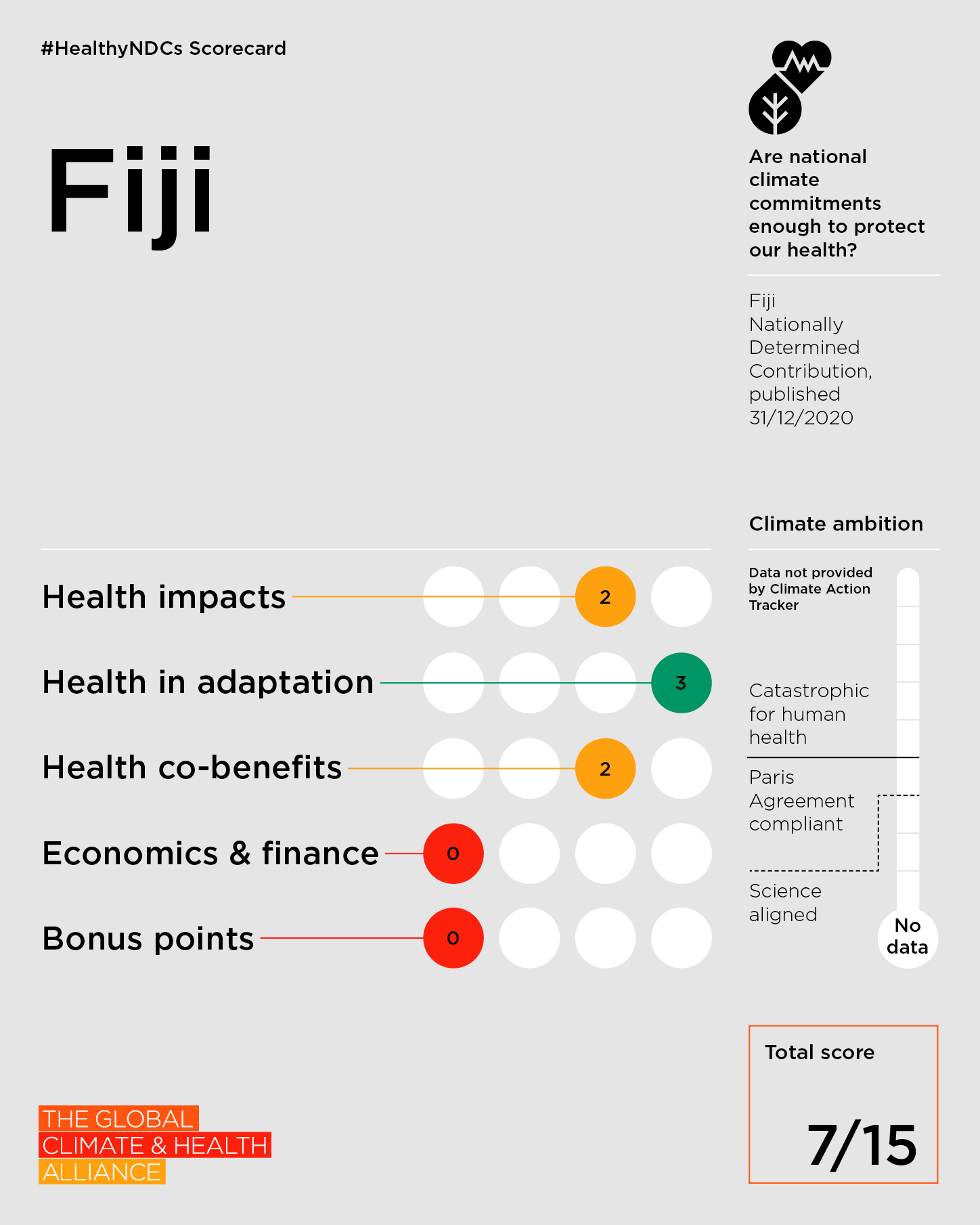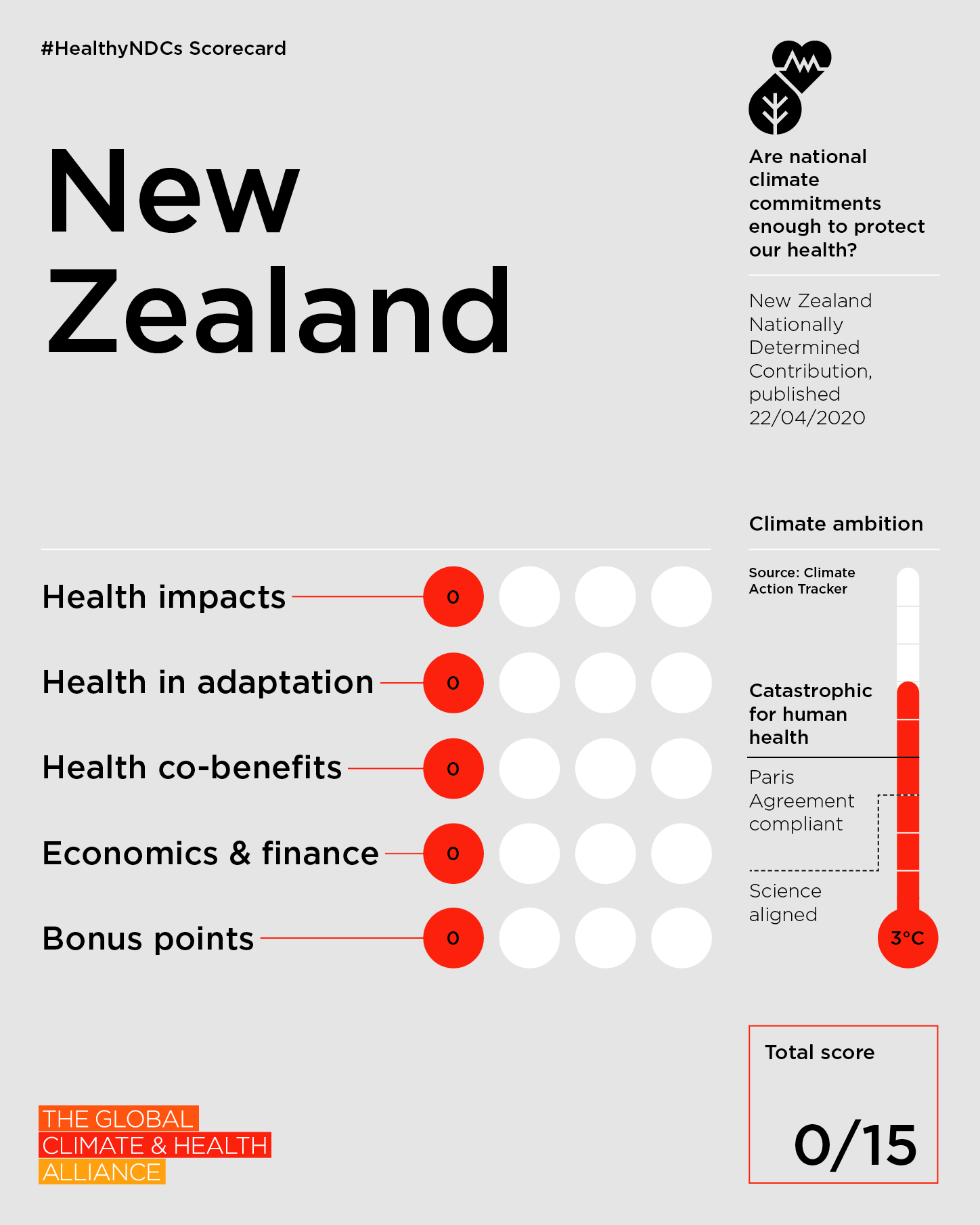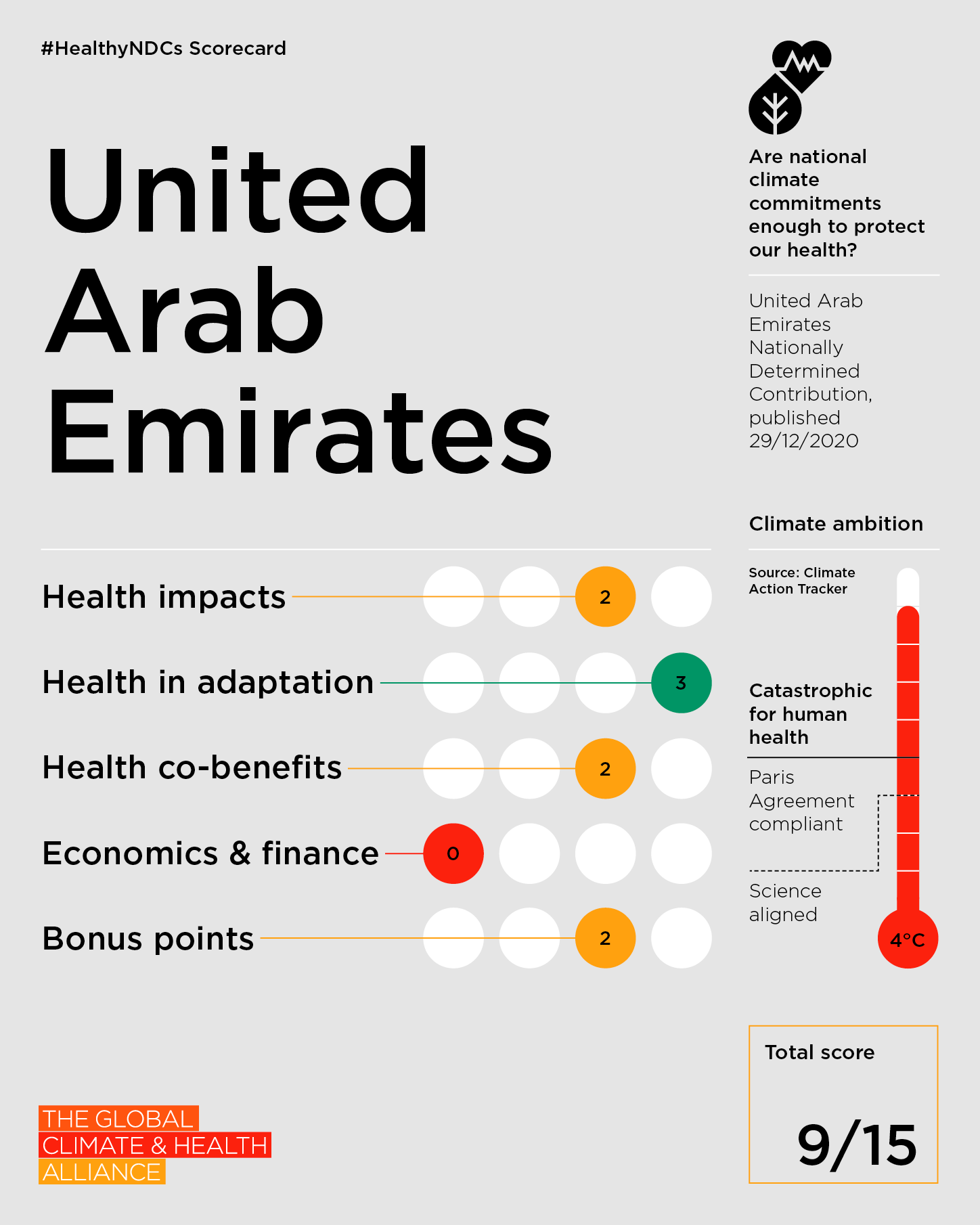¿Son suficientes los compromisos climáticos nacionales para proteger nuestra salud?
Esta primera ronda de Puntuación de NDC Saludables evalúa 40 Contribuciones Determinadas a Nivel Nacional (NDC) que cubren 66 países (incluida la NDC conjunta presentada por los 27 países de la Unión Europea). Las NDC continuarán siendo analizadas en los meses previos a las negociaciones climáticas de la ONU en noviembre, COP26.
Las NDC se evaluaron en función de su atención a cinco categorías de salud: impactos en la salud, salud en las medidas de adaptación, beneficios colaterales para la salud, economía y finanzas, y puntos de bonificación disponibles para la prominencia e integración general de la salud. Había tres puntos disponibles para cada categoría, con una puntuación total posible de «salud» de 15.
Además, la puntuación también incluye información sobre el nivel de ambición climática en las NDC (si un país se compromete a reducir sus emisiones lo suficiente para alinearse con los objetivos de temperatura del Acuerdo de París), según disponibilidad de la información en Climate Action Tracker, ya que aumento general de la temperatura es el factor que, en última instancia, tendrá la mayor influencia sobre la salud.
Las NDC se publican en el sitio web de la CMNUCC y un resumen completo de los métodos está disponible aquí. Como las NDC restantes y recientemente publicadas continúan siendo analizadas en los meses previos a la COP, los resultados se compartirán a continuación.
El contenido de las NDC proporciona una instantánea general de las prioridades de los gobiernos en relación con el cambio climático, y este análisis sirve como barómetro de la medida en que se reconocen y se abordan los vínculos intrínsecos entre la salud y el cambio climático.
 Esta evaluación se basa únicamente en el análisis de las NDC de cada país y no en otras políticas más amplias. Es importante señalar que, en lugar de incluir medidas de adaptación en sus NDC, muchos países que son más económicamente desarrollados tienen estrategias de adaptación independientes y, por lo tanto, se les otorgó una puntuación de adaptación más baja de lo que sería en caso contrarrio. Sin embargo, es notable que a pesar de los recursos muy limitados de muchas naciones del Sur Global, los países de ingresos bajos y medianos obtuvieron los puntajes más altos. Estos países son los que menos han contribuido a las emisiones responsables del cambio climático y ya están experimentando los impactos en la salud más graves.
Esta evaluación se basa únicamente en el análisis de las NDC de cada país y no en otras políticas más amplias. Es importante señalar que, en lugar de incluir medidas de adaptación en sus NDC, muchos países que son más económicamente desarrollados tienen estrategias de adaptación independientes y, por lo tanto, se les otorgó una puntuación de adaptación más baja de lo que sería en caso contrarrio. Sin embargo, es notable que a pesar de los recursos muy limitados de muchas naciones del Sur Global, los países de ingresos bajos y medianos obtuvieron los puntajes más altos. Estos países son los que menos han contribuido a las emisiones responsables del cambio climático y ya están experimentando los impactos en la salud más graves.
Los países responsables de la mitad de las emisiones globales aún tienen que actualizar públicamente sus compromisos climáticos nacionales antes de la COP26. Por lo tanto, existe una gran oportunidad para que los gobiernos establezcan ambiciosos objetivos de reducción de emisiones y cosechen los beneficios para la salud de una acción climática bien considerada, y para impulsar sus economías.
Para los países que ya han presentado una NDC, colocar la salud en el centro de las políticas implementadas en los sectores de energía, alimentación y agricultura y transporte para lograr reducciones de emisiones específicas generará beneficios económicos y de salud gracias a una mejor calidad del aire, dietas saludables y actividad física.
Por su naturaleza, las NDC se refieren principalmente a planes y objetivos futuros. Si bien el compromiso es un requisito previo para una acción ambiciosa, la salud solo se beneficiará si estos compromisos se cumplen.
GCHA está muy agradecida con las siguientes personas por su trabajo y orientación para hacer posible la iniciativa Puntuación: Iris Martine Blom, Omnia El Omrani, Laura Jung, Juliette Mattijsen, Blanca Paniello Castillo, Kim Robin van Daalen y Arthur Wyns.
“Costa Rica reconoce que el cambio climático afectará la salud de las personas y que debemos tomar medidas urgentes. Afortunadamente, tenemos las herramientas para abordar este problema. Las inversiones necesarias para abordar el cambio climático mejorarán la calidad del aire, aliviarán la presión de nuestros sistemas de atención médica y mejorarán nuestro bienestar. El reconocimiento de las políticas climáticas de Costa Rica en este ranking muestra una vez más que el país es líder mundial en la lucha contra el cambio climático y que estas acciones están al alcance de países de todos los tamaños”.
Andrea Meza, Ministra de Ambiente y Energía de Costa Rica.
El Ranking
Para compartir las tarjetas de puntuación de los países en las redes sociales, utilice las tarjetas de Twitter aquí y el hashtag #HealthyNDCs.
Argentina reconoce múltiples impactos en la salud en su NDC, que incluyen olas de calor y frío, enfermedades transmitidas por vectores e inundaciones. Con respecto a la adaptación, la NDC incluye una referencia a un plan de acción específico para la salud y el cambio climático, el Plan de Acción Nacional de Salud y Cambio Climático (PANSyCC). Argentina fue el primer país en incluir medidas de mitigación del sector de la salud en su NDC, y también incluye la salud como un “eje rector” que sustenta gran parte del contenido de su NDC. También se reconoce el financiamiento necesario para la mitigación en el sector salud. La salud y el efecto del cambio climático en la humanidad se menciona al comienzo de la NDC, que también se refiere a la inclusión del derecho a un medio ambiente saludable en la Constitución Nacional de 1994. La NDC también hace varias referencias a la igualdad, en términos de poblaciones vulnerables y participación en los procesos de toma de decisiones. A pesar de la priorización de la salud y la equidad, el nivel de ambición climática de Argentina no está alineado con el Acuerdo de París.
La NDC de Australia no menciona consideraciones relacionadas con la salud y no se ajusta al Acuerdo de París. A pesar de afirmar estar «en camino de cumplir y superar su objetivo para 2030» establecido en su NDC de 2016, y experimentar devastadores incendios forestales anuales, Australia optó por no aumentar este objetivo insuficientemente ambicioso para reducir las emisiones de gases de efecto invernadero, poniendo en peligro la salud de la población nacional y de personas en todo el mundo.
La NDC chilena incluye detalles sustanciales sobre las medidas de adaptación para la salud y el agua. Chile menciona la contaminación del aire, los beneficios de los bosques y la calidad del agua para la salud mental y la calidad de vida, respectivamente. La NDC incluye un objetivo específico sobre la reducción del carbono negro, relacionándolo con la salud respiratoria y reconociendo los costos asociados. Se asignaron 2 puntos de bonificación en reconocimiento a varios párrafos con menciones destacadas de la salud y la integración de la salud en todo el NDC. Aunque la NDC de Chile señala los impactos en la salud del calentamiento más allá de 1.5 ° C, su NDC está alineada con 3°C de calentamiento.
Costa Rica recibió la máxima calificación en todas las categorías de salud excepto en economía y finanzas. Su NDC también está alineada con el Acuerdo de París. Costa Rica destaca los vínculos entre el cambio climático y las enfermedades transmitidas por vectores, las zoonosis y la seguridad alimentaria y la nutrición y se compromete a monitorear dichos impactos. Las consideraciones de adaptación para la salud se mencionan en detalle en la NDC. En términos de cobeneficios, Costa Rica destaca el beneficio de metas de mitigación específicas y con plazos determinados en los sectores de transporte y energía para la salud. La salud también figura en la sección de financiación de la NDC. Además de una sección dedicada a la salud, Costa Rica recibió un tercer punto de bonificación por la integración constante de la salud en toda la NDC.
La NDC de la UE solo hace una referencia a la salud, en relación con los beneficios colaterales de las soluciones basadas en la naturaleza. Dado el amplio seguimiento de los vínculos entre la salud y el clima por parte del Observatorio Europeo del Clima y la Salud, organizado por la Agencia Europea de Medio Ambiente, la ausencia de dicho reconocimiento en la NDC es notable. El nivel de ambición en la NDC no está cuantificado por Climate Action Tracker, pero el objetivo de la UE de una reducción del 55% en las emisiones de gases de efecto invernadero para 2030 en comparación con 1990 no alcanza los pedidos de la Alianza para la Salud y el Medio Ambiente (HEAL) y otros de al menos un 65%. reducciones.
El Primer Ministro Bainimarama de Fiji solicitó a la OMS que preparara un informe sobre la salud y el cambio climático para presentarlo en la COP24, tras la Presidencia de la COP23 de Fiji. La NDC 2020 de Fiji reconoce los impactos en la salud del cambio climático, incluidas las enfermedades transmitidas por vectores y el agua, y la vulnerabilidad al calor cada vez mayor de las personas que viven con enfermedades no transmisibles. La referencia a las directrices nacionales para instalaciones sanitarias resilientes al clima y ambientalmente sostenibles le aseguró puntos en las categorías de adaptación y cobeneficios. También se hace referencia a los cobeneficios para la salud de las soluciones e intervenciones basadas en la naturaleza relacionadas con los océanos. Más ampliamente, Fiji menciona la necesidad de intervenciones sensibles al género en toda su NDC.
La NDC de Kenia menciona la vulnerabilidad general a la salud, la pérdida de vidas debido a las inundaciones y también se refiere a la hambruna. Menciona el número de personas que se quedaron sin comida ni agua durante un período de sequía entre 2014 y 2018, e incluye una meta para medir la incidencia de la malaria y otras enfermedades transmitidas por vectores. El sector de la salud y también el agua y el saneamiento figuran en la sección de adaptación de la NDC, junto con la gestión de sequías e inundaciones que se mencionan anteriormente en la NDC como relacionados con la salud. La NDC de Kenia está alineada con el Acuerdo de París. El financiamiento internacional adicional puede aumentar la viabilidad de las intervenciones de cobeneficios para la salud.
No hay contenido en la NDC actualizada de Nueva Zelanda que haga referencia a la salud. Este fue también el caso de la presentación de Nueva Zelanda de 2016. También está por debajo del nivel de ambición requerido para cumplir con el Acuerdo de París. En particular, la presentación actualizada de Nueva Zelanda fue la más corta de todos los países analizados, con poco más de una página. Para un país que aparentemente tiene un gobierno especialmente progresista, estos resultados son sorprendentes. Nueva Zelanda estuvo a la vanguardia de la respuesta a la pandemia de COVID-19, pero no reconoce las amenazas para la salud del cambio climático en su NDC, que plantean un riesgo aún mayor. El asesoramiento proporcionado en junio por la Comisión Nacional de Cambio Climático describe cómo reducir los contaminantes climáticos de larga duración, como el dióxido de carbono, en un 63% entre 2019 y 2035. Nueva Zelanda ahora tiene una oportunidad para actualizar su NDC antes de la COP26 con mayor ambición y debida atención a la salud pública.
La NDC de Nepal está alineada con el Acuerdo de París, que en sí mismo ofrece protección para la salud pública. Las menciones específicas a la salud en la NDC de Nepal son menos prominentes. Se señala que la salud, el agua potable y el saneamiento están incluidos en el plan nacional de adaptación. Nepal también busca reducir las emisiones del sector de la salud al prohibir la quema de desechos de la atención médica, en lugar de establecer requisitos para una gestión adecuada de los desechos. Nepal afirma la importancia de no dejar a nadie atrás y también planea desarrollar un plan de acción para integrar la igualdad de género y la inclusión social en el logro de las metas de las NDC, ayudando así a abordar los determinantes sociales de la salud.
Corea del Sur ocupa uno de los últimos lugares tanto en términos de atención a la salud como de su ambición general, que está alineada con un aumento de temperatura de 4°C, catastrófico para la salud humana. Se menciona la vulnerabilidad del sector salud, pero solo como parte de una evaluación más amplia, y la salud no se destaca como un sector en la planificación de la adaptación, por lo que solo se asignó un punto. También se mencionaron la remodelación ecológica de hospitales y la inversión para apoyarla. Existe la esperanza de que Corea del Sur pueda presentar una actualización de su NDC antes de la COP, con mayor ambición. Esto beneficiaría directamente a la gente de Corea del Sur a través de los beneficios colaterales para la salud de las soluciones climáticas, al tiempo que cumple con sus responsabilidades en virtud del Acuerdo de París. La presentación de una NDC actualizada también brindaría la oportunidad de aumentar la atención a la salud en toda su NDC.
La NDC del Reino Unido alude al impacto del cambio climático en el hambre debido a la inseguridad alimentaria. El Reino Unido no recibió ningún punto en la categoría de adaptación, pero el Reino Unido y, de hecho, muchas otras economías desarrolladas se centran en la mitigación en la NDC y presentan una Comunicación de adaptación separada a la CMNUCC. De lo contrario, el Reino Unido habría recibido 2 puntos por la salud en la adaptación. La NDC del Reino Unido se refiere a los beneficios colaterales para la salud que se pueden obtener a través de sistemas de transporte y alimentos más sostenibles, y cita la contaminación del aire como el principal riesgo ambiental para la salud en el Reino Unido. Se otorgaron puntos de bonificación por el párrafo dedicado a la salud y la contaminación del aire, así como por la especificidad de las políticas para generar beneficios colaterales para la salud. La NDC no ha sido analizado por Climate Action Tracker, por lo que no pudimos incluir el nivel de ambición climática.
La NDC de los EAU menciona tanto el calor (específicamente el estrés por calor, la insolación y el agotamiento por calor) como los impactos del cambio climático en la salud general en su NDC. Además de las medidas individuales para mejorar la adaptación a los impactos en la salud, los EAU desarrollarán una política y un plan de acción sobre la salud y el cambio climático. La NDC de los EAU también menciona el monitoreo de los contaminantes del aire e incluye una sección dedicada a la salud pública. A pesar de experimentar graves impactos en la salud del cambio climático, los EAU están más enfocados en las medidas de adaptación, que tienen un potencial finito para proteger la salud, que en abordar sus altas emisiones. Según Climate Action Tracker, el NDC está alineado con 4C de calentamiento, considerado «muy insuficiente». Como país de altos ingresos, que siente impactos climáticos significativos, se podría esperar que los EAU tengan tanto el motivo como los medios para establecer objetivos de reducción de emisiones mucho más ambiciosos y, por lo tanto, también cumplir con sus obligaciones internacionales.
La NDC de los Estados Unidos reconoce el cambio climático como una “amenaza existencial” que exige una acción audaz, aludiendo a los impactos del cambio climático en la salud. Las medidas de adaptación en el sector de la construcción se describen como protección de la salud. Los cobeneficios para la salud se mencionan en las secciones de la NDC dedicadas a la energía y el transporte, y se cuantifican en términos de la cantidad de vidas que podrían salvarse mejorando la calidad del aire. También se otorgó un punto en la categoría de economía y finanzas por la afirmación de que “el costo de la inacción supera con creces el costo de la acción en términos económicos y humanitarios”. En términos más generales, la NDC hace varias menciones a la equidad. La NDC de EE. UU. no está analizado por Climate Action Tracker, por lo que no pudimos incluir el nivel de ambición climática.
La NDC vietnamita incluye una referencia a las olas de calor, el acceso a agua potable y una miríada de enfermedades infecciosas como impactos en la salud del cambio climático, y cita la vulnerabilidad particular de las personas con condiciones preexistentes, los ancianos, las mujeres y los niños. También cuantifica otros riesgos, como el número de personas en riesgo de enfermedades transmitidas por el agua y desnutrición. Algunos de estos impactos humanos también se vincularon a una suma financiera del costo de los impactos climáticos. También se incluyen brevemente las medidas de adaptación relacionadas con la salud y el acceso a agua limpia e higiénica. En términos de cobeneficios, se menciona la necesidad de reducir el consumo de energía en hospitales y centros de salud comunitarios, con una breve mención de la necesidad de inversión para lograrlo. Vietnam incluye una sección dedicada a la salud pública, la igualdad de género y la protección infantil en su NDC. A pesar de todo esto, Vietnam tiene el nivel más bajo de ambición climática de todas las NDC incluidas en esta ronda de análisis, alineado con un aumento de temperatura > 4°C. La mitigación del clima a menudo ofrece beneficios colaterales sustanciales a corto plazo para la salud, con ahorros para la salud que podrían compensar algunos de los costos de la acción climática. Junto con la financiación internacional, esto puede aumentar la viabilidad de las medidas para reducir las emisiones y ofrecer grandes beneficios a la población de Vietnam.



